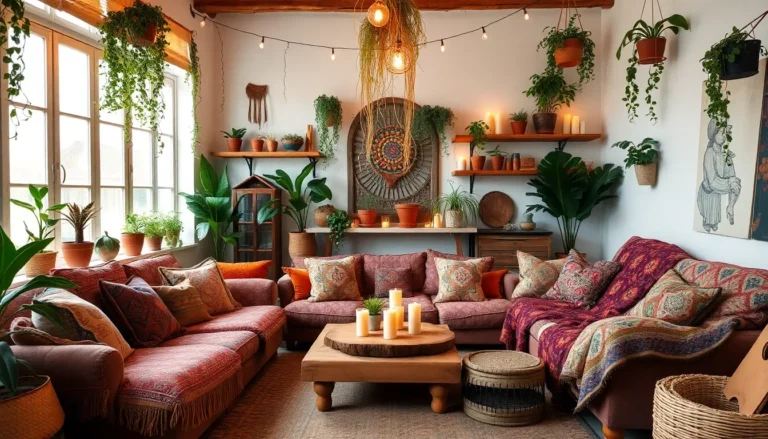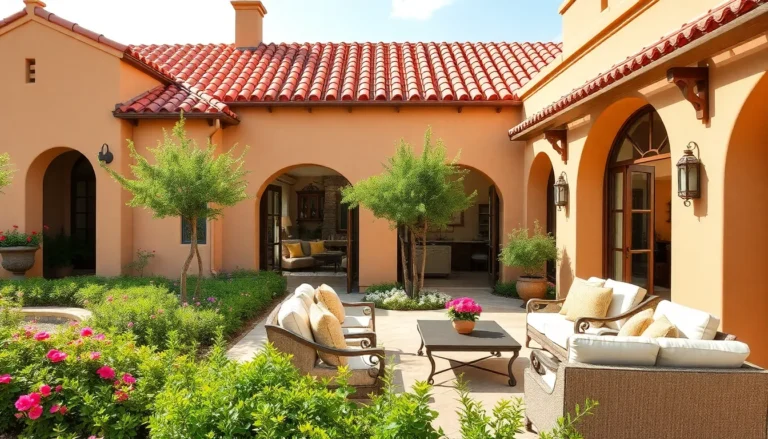Table of Contents
ToggleCreating the perfect interior ambiance is like crafting a delicious recipe. Toss in a dash of color, a sprinkle of texture, and a generous helping of lighting, and voilà! You’ve got a space that not only looks good but feels good too. It’s not just about aesthetics; it’s about setting the mood and making every corner of your home or office sing with personality.
Understanding Interior Ambiance Strategy
Creating the right interior ambiance plays a significant role in shaping the experiences within a space. This strategy involves careful consideration of various elements.
Definition and Importance
Interior ambiance strategy refers to the approach of designing spaces to evoke specific feelings. It creates a mood that aligns with the intended function of the area. A well-executed ambiance fosters comfort, enhances aesthetic appeal, and reinforces brand identity in commercial settings. Understanding how different elements interact helps in crafting environments that promote well-being and productivity. Prioritizing this strategy allows homeowners and businesses to create spaces that resonate with their personality and mission.
Key Components of Ambiance
Key components of ambiance include color, lighting, and texture. Color choices impact emotions and perceptions. For example, warm colors like reds and oranges energize, while cool blues and greens offer tranquility. Lighting significantly affects mood as well; soft, warm lights create coziness, whereas bright, cool lights enhance focus. Texture adds depth and interest, creating a tactile experience for occupants. Integrating these elements leads to a harmonious environment, ensuring that each space communicates a desired atmosphere and enhances overall well-being.
Creating the Right Atmosphere
Creating the right atmosphere involves strategic elements that enhance overall environment quality. Careful consideration of color, lighting, and texture lays the groundwork for inviting spaces.
Color Psychology in Interior Design
Color psychology significantly influences emotions and perceptions. For instance, warm colors like red and orange generate energy and excitement, making them suitable for social spaces. Cool colors such as blue and green promote calmness, ideal for relaxation areas. Neutral shades can provide a balanced backdrop while allowing furniture and decor to stand out. Effective color combinations create visual harmony, ensuring a cohesive look throughout any room. By assessing individual preferences and the room’s intended purpose, designers effectively determine the optimal color palette.
Lighting Techniques for Ambiance
Lighting techniques play a pivotal role in shaping ambiance. Soft, warm lighting creates an inviting atmosphere, perfect for living areas and bedrooms. Conversely, brighter, cooler lighting enhances focus and productivity in workspaces. Layered lighting, incorporating ambient, task, and accent lights, achieves flexibility in mood settings. Dimmer switches offer control over light intensity, adapting to different activities throughout the day. Additionally, natural light should be maximized when possible, as it positively affects mood and well-being. Through thoughtful lighting design, spaces transform to evoke desired feelings, enriching the overall experience.
Incorporating Texture and Materials
Texture and materials play a crucial role in creating an inviting interior ambiance. By selecting various elements, one can enhance visual interest and comfort in a space.
Choosing the Right Fabrics
Fabrics significantly influence the atmosphere. Soft textiles like velvet or cotton provide warmth, while sleek materials such as silk or linen introduce elegance. Incorporating mixed materials adds depth, breaking monotony and creating tactile experiences. Consider layering fabrics through cushions, throws, and drapes to achieve a cozy vibe. Opt for patterns that reflect personal style and resonate with the intended room use. Natural fibers like wool or jute offer durability and a connection to nature, enhancing a grounded ambiance. Selecting the right fabrics helps convey emotions, ultimately enriching the overall space.
The Role of Furniture in Ambiance
Furniture selection greatly impacts ambiance. Curated pieces establish functionality and define spaces. Choosing comfortable seating encourages relaxation, while sleek, minimalist designs promote productivity. Incorporating varied textures within furniture, such as leather, wood, or metal, adds visual intrigue. Arrange furniture to facilitate flow, ensuring spaces feel open and inviting. Accent pieces such as tables or shelves can serve as focal points, showcasing personality. Thoughtful layering of materials in furniture creates a harmonious environment. Prioritizing the right furniture enhances the overall interior experience.
The Impact of Sound and Scent
Sound and scent significantly contribute to creating an inviting interior ambiance. By addressing both elements, spaces can evoke specific emotions while enhancing overall experience.
Acoustic Design in Interiors
Acoustic design shapes the auditory environment within spaces. Soft materials like carpets and curtains absorb sound, reducing echo and noise levels. Minimizing disruptive sounds fosters concentration and relaxation. Specific acoustic treatments, like ceiling panels and wall cushions, offer further sound management. Implementing soundscapes, such as gentle background music or nature sounds, can also enhance mood. These choices create environments that support intended functions, whether for work or leisure.
Utilizing Fragrance for Mood
Fragrance plays a vital role in mood enhancement within interiors. Scented candles and essential oil diffusers introduce pleasant aromas that evoke specific feelings. For example, lavender promotes relaxation, while citrus scents energize and uplift. Strategically placed scents can create memorable experiences for visitors or residents. Selecting fragrances that align with space purpose enriches the ambiance and reinforces emotional connections. Regularly refreshing these scents ensures continual engagement and comfort.
Conclusion
Creating the perfect interior ambiance is a thoughtful process that requires attention to detail. By strategically combining color, lighting, texture, sound, and scent, anyone can transform a space into a haven that reflects personal style and purpose.
This approach not only enhances aesthetic appeal but also fosters emotional connections that improve well-being and productivity. Whether designing a cozy home or an inspiring office, prioritizing these elements ensures that each area serves its intended function while inviting comfort and engagement.
Ultimately, an effective interior ambiance strategy enriches experiences and elevates the quality of life in any environment.







